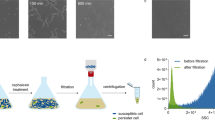Abstract
In a genetically uniform bacterial population a small subset of antibiotic-susceptible cells enter an antibiotic tolerant state and are hence referred to as persisters. These have been proposed to be rare phenotypic variants with several stochastically activated independent parallel processes. Here we show an overlooked phenomenon, bacterial tolerance of extraordinary high levels of ampicillin due to encasement of viable cells by an antibiotic induced network of cell debris. This matrix shields the entrapped cells from contact with the bacteriolytic β-lactam antibiotic ampicillin and may be an underlying cause of notable variations in the level of ampicillin tolerant persisters as well as of considerable medical significance. Disruption of the matrix leads to the rapid elimination of hidden survivors, revealing their metabolically active state.




Similar content being viewed by others
References
Balaban NQ, Merrin J, Chait R, Kowalik L, Leibler S (2004) Bacterial persistence as a phenotypic switch. Science 305:1622–1625
Balaban NQ, Gerdes K, Lewis K, McKinney JD (2013) A problem of persistence: still more questions than answers? Nat Rev Microbiol 11:587–591
Bigger JW (1944) Treatment of staphylococcal infections with penicillin by intermittent sterilisation. Lancet 2:497–500
Burnham GW, Cavanagh HD, Robertson DM (2012) The impact of cellular debris on Pseudomonas aeruginosa adherence to silicone hydrogel contact lenses and contact lenses storage cases. Eye Contact Lens 38:7–15
Dorr T, Vulić M, Lewis K (2010) Ciprofloxacin causes persister formation by inducing the TisB toxin in Escherichia coli. PLoS Biol 8:e1000317
Iwasaki A, Medzhitov R (2015) Control of adaptive immunity by the innate immune system. Nat Immun 16:343–353
Keren I, Kaldalu N, Spoering A, Wang Y, Lewis K (2004) Persister cells and tolerance to antimicrobials. FEMS Microbiol Lett 230:13–18
Lewis K (2010) Persister cells. Annu Rev Microbiol 64:357–372
Moker N, Dean CR, Tao J (2010) Pseudomonas aeruginosa increases formation of multidrug-tolerant persister cells in response to quorum-sensing signaling molecules. J Bacteriol 192:1946–1955
Orman MA, Brynildsen MP (2013) Dormancy is not necessary or sufficient for bacterial persistence. Antimicrob Agents Chemother 57:3230–3239
Schuacher MA, Balani P, Min J, Chinnam NB, Hansen S, Vulić M, Lewis K, Brennan RG (2015) HipBA-promoter structures reveal the basis of heritable multidrug tolerance. Nature 542:59–64
Shah D, Zhang Z, Khodursky AB, Kaldalu N, Kurg K, Lewis K (2006) Persisters: a distinct physiological state of E. coli. BMC Microbiol 6:53
Vega NM, Allison KR, Khalil AS, Collins JJ (2012) Signaling-mediated bacterial persister formation. Nat Chem Biol 8:431–433
Wu Y, Vulić M, Keren I, Lewis K (2012) Role of oxidative stress in persister tolerance. Antimicrob Agents Chemother 56:4922–4926
Acknowledgments
This work was supported by grants P1-0198 and P1-0207 from the Slovenian Research Agency. We thank Miha Črnigoj for technical assistance.
Author information
Authors and Affiliations
Corresponding author
Rights and permissions
About this article
Cite this article
Podlesek, Z., Butala, M., Šakanović, A. et al. Antibiotic induced bacterial lysis provides a reservoir of persisters. Antonie van Leeuwenhoek 109, 523–528 (2016). https://doi.org/10.1007/s10482-016-0657-x
Received:
Accepted:
Published:
Issue Date:
DOI: https://doi.org/10.1007/s10482-016-0657-x




